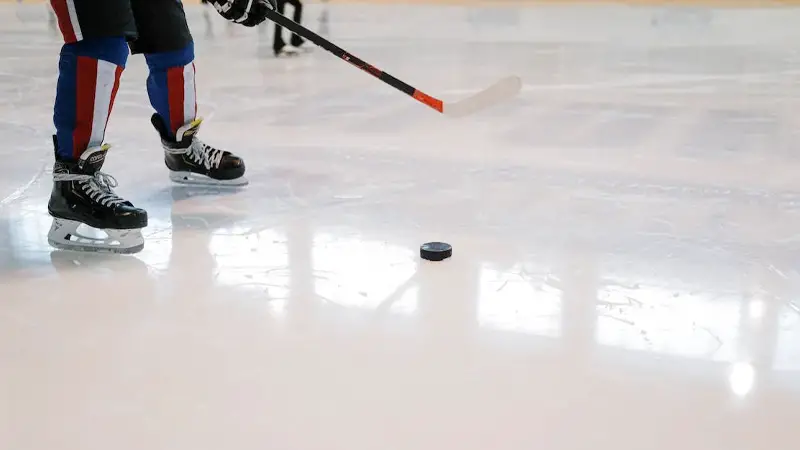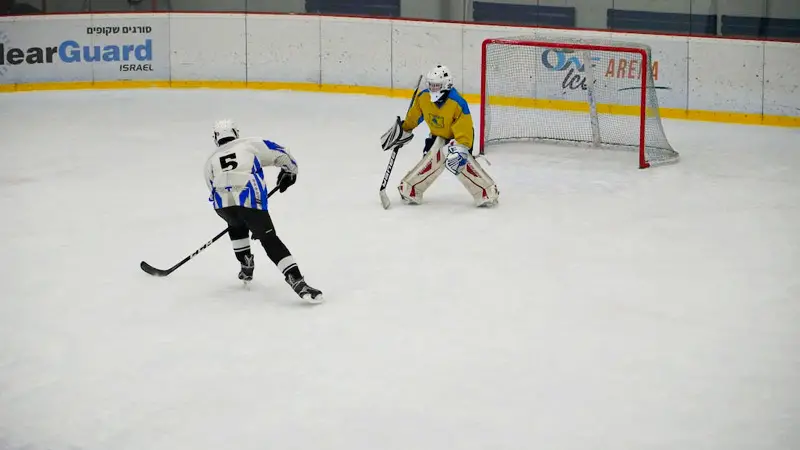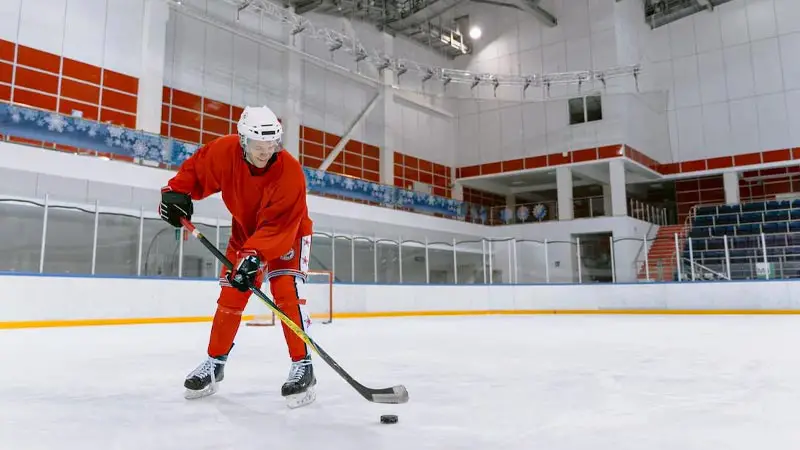Hockey, a sport defined by lightning-fast plays and strategic finesse, places immense significance on the speed of a player’s shot.
In the high-stakes world of professional hockey, particularly the NHL, the average shot speed is a compelling metric that showcases the athleticism and skill of elite players.
From powerful slapshots rocketing at 90-100 miles per hour to nimble wrist shots ranging between 70-90 miles per hour, understanding the nuances of average hockey shot speed unveils the dynamic nature of offensive strategies.
This blog post delves into average hockey shot speed, the various types of shots, and how players optimize their velocity through equipment choices and targeted training strategies.
Join us on a journey through the intricacies of hockey’s fastest shots and the techniques that propel them to astounding speeds. So, stay sharp.
The Basics of the Hockey Shot Speed
The speed of a hockey shot is a critical aspect of a player’s offensive arsenal, influencing the game’s dynamics and challenging goalkeepers.
Understanding the basics of hockey shot speed provides insights into the athleticism and skill required at the highest levels of the sport.
Types of Shots
Different types of shots contribute to varying speeds. A slapshot, executed by winding up and forcefully striking the puck, often boasts the highest speeds, averaging between 90-100 miles per hour in the NHL.
Wrist shots and snapshots, characterized by their quicker releases, typically fall within the 70-90 miles per hour range.
Player Technique
Shot speed is intricately tied to a player’s technique. Proper weight transfer, flexing the stick appropriately, and generating power from the core and legs are key elements.
Professional players hone these techniques to optimize their shot speed and maintain accuracy.
Equipment Impact
The equipment used, especially the stick’s flex and blade design, significantly influences shot speed.
Players often customize their gear to suit their playing style, seeking the right balance between flexibility for power generation and stiffness for control.
Muscle Memory and Training
Achieving consistent high shot speeds requires extensive training and muscle memory development.
Professional players engage in repetitive drills to refine their shooting mechanics, enabling them to execute powerful and precise shots instinctively during fast-paced game situations.
Game Situations and Decision-Making
Beyond raw speed, effective shooting in a game context involves quick decision-making.
Players must choose the right type of shot based on the defensive setup, goalie positioning, and the fleeting opportunities presented during the fast-paced flow of a hockey match.
These fundamental aspects of hockey shot speed shed light on the multifaceted skill set that professional players cultivate to make a decisive impact on the ice.
What Is the Average Hockey Shot Speed?

In the dynamic realm of professional hockey, the velocity of shots serves as a compelling measure of player skill.
Specifically, within the NHL, the average slapshot registers an impressive 90-100 miles per hour, reflecting the extraordinary power and precision wielded by elite athletes.
Notably, this formidable speed showcases the pinnacle of shooting prowess in the highest echelons of the sport.
On a broader scale, encompassing various types of shots, professional players typically maintain a formidable range, with average speeds ranging from 70 to 90 miles per hour.
This spectrum highlights the nuanced nature of offensive strategies employed by skilled hockey players.
As these athletes navigate the fast-paced, high-stakes environment of the game, their ability to unleash shots with remarkable speed stands as a testament to the athleticism and training embedded in the sport at its highest levels.
Factors Influencing Hockey Shot Speed
The velocity of a hockey shot is the result of a complex interplay of various factors, each contributing to the overall speed and effectiveness of a player’s offensive maneuver.
Examining these influencing factors provides a comprehensive understanding of the dynamics behind the impressive shot speeds seen in professional hockey.
Stick Flex and Type
The design and characteristics of a player’s hockey stick play a pivotal role in shot speed.
Stick flex, determined by the stick’s construction materials and the player’s weight, influences the amount of stored energy during a shot.
Players often select sticks with specific flex ratings to optimize power generation.
Player Strength and Technique
The physical strength of a player, particularly in the core and lower body, directly impacts shot speed.
Proper technique, including weight transfer and the mechanics of the shot, is equally crucial. A combination of strength and refined technique allows players to unleash powerful and accurate shots.
Skating Speed and Momentum
The speed at which a player approaches a shot significantly affects the resulting velocity.
Skating with momentum adds kinetic energy to the shot, amplifying its speed. Players adept at seamlessly transitioning from skating to shooting can leverage their speed for more potent offensive plays.
Puck Contact Point
The point of contact between the stick and the puck influences the trajectory and speed of the shot.
A well-timed and precise contact point allows players to maximize the transfer of energy, resulting in a faster shot. Professional players develop a keen sense of puck control to consistently achieve optimal contact.
Game Situation and Pressure
The context of a game, including defensive pressure and the proximity of opponents, can impact shot speed.
Players must make split-second decisions on the type and speed of the shot based on the evolving dynamics of the play. The ability to execute high-speed shots under pressure is a hallmark of elite players.
Understanding these diverse factors underscores the intricate nature of achieving impressive shot speeds in hockey.
Training Strategies to Improve Shot Speed

Enhancing shot speed in hockey requires a combination of targeted training strategies aimed at refining both physical attributes and technical skills.
Players looking to boost their offensive capabilities can benefit from a systematic approach that encompasses various aspects of their game.
Strength and Conditioning Programs
Implementing tailored strength and conditioning regimens is fundamental to improving shot speed.
Focusing on exercises that enhance core strength, leg power, and explosive movements contributes to a player’s ability to generate the necessary force for powerful shots.
Regular off-ice workouts complement on-ice training, fostering overall athletic development.
Shot-Specific Drills
Incorporating shot-specific drills into practice sessions allows players to refine their shooting techniques.
Targeted exercises can emphasize aspects such as weight transfer, stick flex utilization, and puck control.
Repetition of these drills helps build muscle memory, enabling players to execute powerful and accurate shots instinctively.
Stick Flex and Equipment Optimization
Players should experiment with different stick flexes and blade patterns to identify the equipment configuration that maximizes their shot speed.
Fine-tuning gear choices based on personal preferences and playing style is crucial. Regularly assessing and updating equipment ensures that players are utilizing the latest advancements in stick technology.
Skating Speed Development
Since skating speed contributes significantly to shot velocity, players should focus on improving their overall speed and agility on the ice.
Skating drills that emphasize quick accelerations, tight turns, and directional changes not only enhance a player’s skating ability but also contribute to the momentum required for powerful shots.
Game-Situation Simulations
Training scenarios that simulate real-game situations under varying levels of pressure help players develop the mental acuity needed to execute high-speed shots during matches.
These simulations can include rapid decision-making, adapting to defensive pressure, and shooting under time constraints.
Replicating game scenarios in practice enhances a player’s ability to translate training gains into on-ice performance.
By integrating these training strategies into their routines, hockey players can systematically elevate their shot speed.
FAQs
What is the average speed of a slapshot in professional hockey?
The average speed of a slapshot in professional hockey, particularly in the NHL, falls in the impressive range of 90 to 100 miles per hour.
This showcases the tremendous power and precision that elite players bring to their offensive plays.
How does the speed of different types of shots vary in hockey?
Various types of shots contribute to different speeds in hockey. A slapshot typically ranges from 90 to 100 miles per hour, while wrist shots and snap shots fall between 70 to 90 miles per hour.
The speed variation reflects the diversity of offensive strategies employed by skilled players.
What factors influence the speed of a hockey shot?
Several factors influence hockey shot speed, including stick flex, player strength, skating speed, puck contact point, and game situations.
The interplay of these elements determines the velocity and effectiveness of a player’s shot, showcasing the multifaceted nature of this crucial skill.
How do players optimize shot speed through equipment choices?
Players optimize shot speed by carefully selecting equipment, focusing on stick flex and blade design. Tailoring these elements to personal preferences and playing style enhances the transfer of energy during shots.
Regularly assessing and updating gear ensures players benefit from advancements in stick technology.
Can shot speed in hockey be improved through training?
Yes, shot speed in hockey can be significantly improved through targeted training strategies.
Strength and conditioning programs, shot-specific drills, equipment optimization, skating speed development, and game-situation simulations collectively enhance a player’s ability to generate powerful and precise shots, contributing to their overall offensive prowess.
Wrapping Up
In the realm of hockey, where split-second decisions can determine victory, shot speed is a defining element of a player’s prowess.
From the thunderous slapshots that test the limits of precision to the swift wrist shots executed with finesse, the diversity in speed mirrors the strategic depth within the game.
As players continually refine their techniques, harness the right equipment, and undertake targeted training, the quest for the perfect shot remains an ever-evolving journey.
The average hockey shot speed encapsulates the fusion of athleticism, skill, and strategy that transforms a frozen arena into a dynamic stage for extraordinary feats.
Ultimately, it is through understanding and appreciating these intricacies that we gain a profound insight into the captivating spectacle of hockey’s fastest shots. Thank you so much.








James Felix